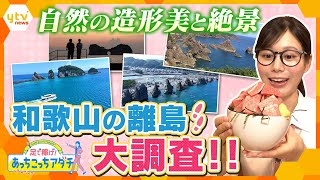
Island specialist and photographer Sei Yamaoka, who has visited around 600 islands across Japan while working as a company employee, explained that many of Wakayama’s islands feature remarkable geological formations and are celebrated as scenic sites.
One of the first stops was Kinoshima, known for its unusual rock formations, including a massive hollow opening in the cliffs of Shionomisaki. The area is compared to Matsushima in Miyagi Prefecture, one of Japan’s three most famous scenic spots. Visitors can also spot dolphins up close, as the area serves as a training site before the animals are transferred to aquariums nationwide.
Among the islands, Nakano Island stands out for its hot spring hotel, offering open-air baths with ocean views accessible by boat. From there, the journey continued to Nachikatsuura, where the local specialty is tuna. Despite operating only during lunchtime, the well-known Maguro-no-Yama restaurant draws large crowds daily, serving lavish bowls of fresh bluefin tuna, thickly cut and piled high over rice.
Travel then shifted toward Oyodo, where at low tide it becomes possible to approach the striking “Hashigui-iwa,” a row of more than 40 towering rock pillars formed by marine erosion. The unusual formations stretch some 900 meters into the sea and are designated a national natural monument.
The highlight of the tour was Kii Oshima, the prefecture’s largest inhabited island with about 1,000 residents. The island is connected by a bridge and features historical sites such as Japan’s oldest stone lighthouse. From Oshima, visitors can view the dramatic pyramid-like rock formations of Kii-Oshima Bay, a landscape shaped over thousands of years.
The journey concluded in Shirahama at Engetsu Island, one of Japan’s top 100 sunset spots. Its distinctive round hole aligns perfectly with the setting sun during certain times of the year, creating a scene that draws photographers and tourists alike.
The exploration of Wakayama’s islands revealed not only spectacular coastal landscapes but also unique food culture and traditions, offering visitors an experience of natural beauty and local hospitality rarely found elsewhere.
Source: YOMIURI



